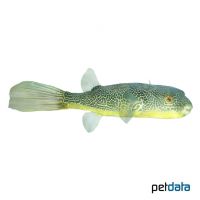Giant Puffer (Tetraodon mbu)
| Giant Puffer Tetraodon mbu | |
|---|---|
| Name | Giant Puffer |
| Name Lat. | Tetraodon mbu |
| Family | Puffers |
| Family lat. | Tetraodontidae |
| Order | Puffers & Filefishes |
| Order lat. | Tetraodontiformes |
| Origin | Africa |
| Habitat | Rivers, lakes |
| Diet | Carnivore |
| pH | 7.0-8.0 |
| Behavior | Aggressive |
| Keeping | Individual |
| Care Level | Experts only |
| Reproduction | Egg scatterer |
| Breeding | None reported |
| Life Span | 8-12 years |
| Protection | No |
| Metric Units | |
| Size | 60 cm |
| Temperature | 24-26 °C |
| Hardness | 10-25 °dH |
| Aquarium | ~ 3,000 l |
| US Units | |
| Size | 24" |
| Temperature | 75-79 °F |
| Hardness | 178-445 ppm |
| Aquarium | ~ 800 gal |
Distribution and habitat
The range of the goldring pufferfish extends from the lower and middle Congo River basin to Lake Tanganyika and Lake Malawi. They live in different habitats, such as rivers and lakes, where they usually stay in shady places with dense riparian vegetation
Maintenance
The aquarium should have a robust border planting, with hiding places (stones, roots) and provide sufficient swimming space. A substrate of quartz sand and lava pieces, shaded light (floating plants) and slightly alkaline water is ideal
No ammonia, ammonium and nitrite should be detectable, the nitrate value should not exceed 100 mg/l. To ensure the water quality and oxygen content, a filter and heater adapted to the aquarium size is required, as well as lighting for the species-appropriate day-night rhythm of the animals.
Diet
They are food specialists, eating mainly crustaceans and shellfish. The food supply consists of snails supplemented with live or frozen food, such as shrimp, mosquito larvae, artemia, mysis, etc., as well as fish, shellfish and crab meat or a frozen special food mix. Rarely dry food is accepted
It is recommended to feed small portions several times a day, which are eaten within a few minutes. A regular and varied diet promotes health and increases resistance.
Behaviour and compatibility
It is recommended to keep them individually. Internally they behave very territorial and are often incompatible and biting towards other fish. A socialization is only possible with large defensible fish, such as catfish.
Basically, only compatible fish species with similar demands on water quality and water temperature may be socialized.
Sex dimorphism
No reliable sex differentiation is known. The males are slightly larger than the rounder females.
Reproduction and breeding
There are no known reports of successful breeding in the aquarium.
Important
The goldring pufferfish grow very quickly, but usually do not reach the size in captivity as in nature!
They need the hard shells of snails, or the shells of mussels, shrimps, crabs and crayfish to wear their teeth, which constantly grow back. Too long teeth make it impossible for them to eat and they would starve to death
When threatened, they can inflate to 2-3 times their size by filling their elastic stomach with air or water. The flesh of goldring pufferfish contains tetrodotoxin, a neurotoxin that is deadly to humans and animals.
A container filled with aquarium water should be used for transferring or placing, not a trap net, to prevent the animals from becoming airborne.
The well-being of the fish should be checked regularly. Temperature should be checked daily, pH, hardness and nitrate levels at least every 14 days. Regular partial water changes are recommended, even if the pollutant level has not yet reached the upper limit. Sudden changes in water quality should be avoided. Newly introduced fish must be accustomed slowly to the water in the aquarium.
Further literature can be found in your pet store.
References
Text: petdata; Image: petdata
Source: BMEL (1998): Tierschutzgutachten - Haltung von Zierfischen (Süßwasser); BAENSCH & RIEHL (2004): Aquarien Atlas Bd. 2, Mergus Verlag; ENGELMANN (2005): Zootierhaltung - Tiere in menschlicher Obhut: Fische, Verlag Harri Deutsch
- Gemäß § 21 Abs. 5 Tierschutzgesetz idgF
